Sony FE 24mm f1.4 GM review
-
-
Written by Thomas
In depth
The Sony FE 24mm f1.4 G Master (also known as the SEL24F14GM) is a wide-angle prime lens designed for its Alpha series of full-frame mirrorless cameras. Announced in September 2018, it’s the 30th full-frame mirrorless lens for Sony’s Alpha system, and the eighth to join its premium G Master series, not to mention being the fourth G Master prime lens after the FE 85mm f1.4, FE 100mm f2.8 STF and FE 400mm f2.8.
The FE 24mm f1.4 GM delivers a popular field-of-view that’s wider than 28mm without the distortion related to wider options. The lens combines this coverage with a bright f1.4 focal ratio that’s ideal for low-light use and can also deliver shallow depth-of-field effects, especially when the subject is positioned close to the minimum focusing distance of 24cm. Like all G Master lenses, the FE 24mm f1.4 GM aims to deliver both high resolution across the frame as well as attractive rendering of blurred areas. Its de-clickable aperture ring also makes it great for video work.
To find out how the Sony FE 24mm f1.4 GM performs I tested it against the Zeiss 25mm f2.0 Batis on the 42MP A7R II body and compare it also to the Sigma 24mm f1.4 Art and the Zeiss 28mm f1.4 Otus. So if you’re interested in which wide-angle prime to choose, you’ve come to the right place!
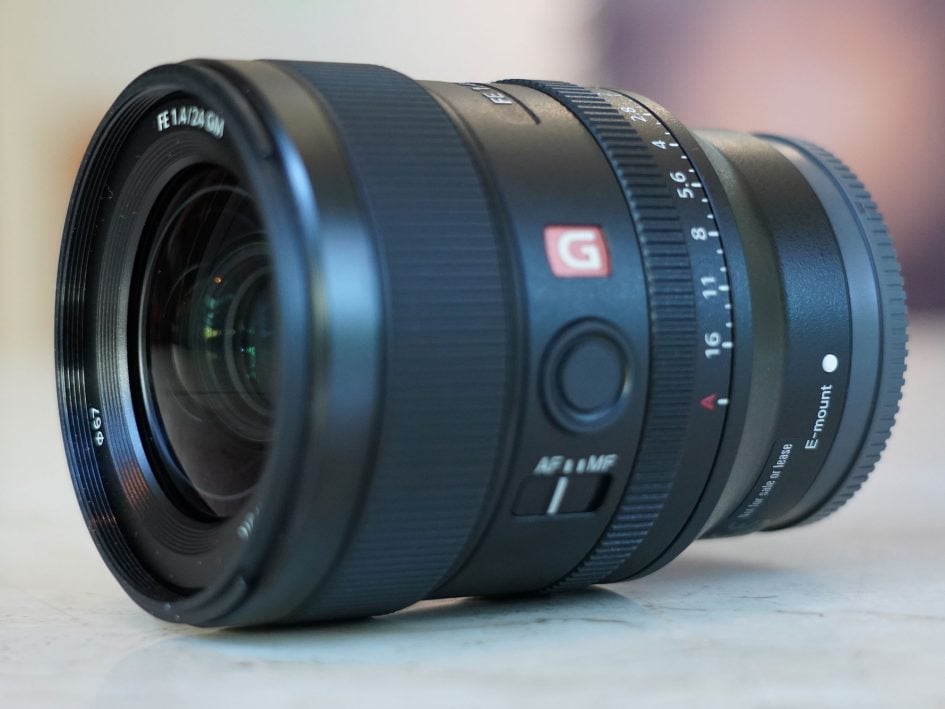
Facts from the catalog
As usual I’ll have a look at the technical data of the Sony FE 24mm f1.4 GM first. I’ve rated the features with a [+] (or [++]), when it’s better than average or even state of the art, a [0] if it’s standard or just average, and [-] if there’s a disadvantage. For comparison I use the Sigma 24mm f1.4 Art and the Zeiss 25mm f2.0 Batis (“Sigma Art” resp. “Zeiss Batis” for short).
Size (diameter x length): 75 x 92mm (3.0 x 3.6in.) plus 31mm for the lens hood which is 95mm in diameter. The Sigma Art is much bigger at 85 x 119mm (without lens hood) as it was designed for DSLRs and has to bridge the difference in flange distance. The Zeiss Batis is 81 x 73mm + 36mm for the lens hood (92mm diameter). [+]
Weight: 445g (15.7 oz.) plus 33g for the lens hood. The Sigma Art is much heavier at 760g (26.8 oz., without lens hood). The Zeiss Batis is the lightest at 335g (11.8 oz.) plus 25g for the lens hood. But then it has a one stop slower focal ratio. [+]
Optics: 13 elements (including 3 special dispersion elements and 2 aspherical elements) in 10 groups. There’s fluorine coating on the front to repel water, dust, and dirt and should make for easier cleaning plus the lens uses Nano coating to reduce flare, glare and ghosting. The Sigma Art has 15 elements in 11 groups, the Zeiss Batis has only 10 elements in 8 groups. [+]
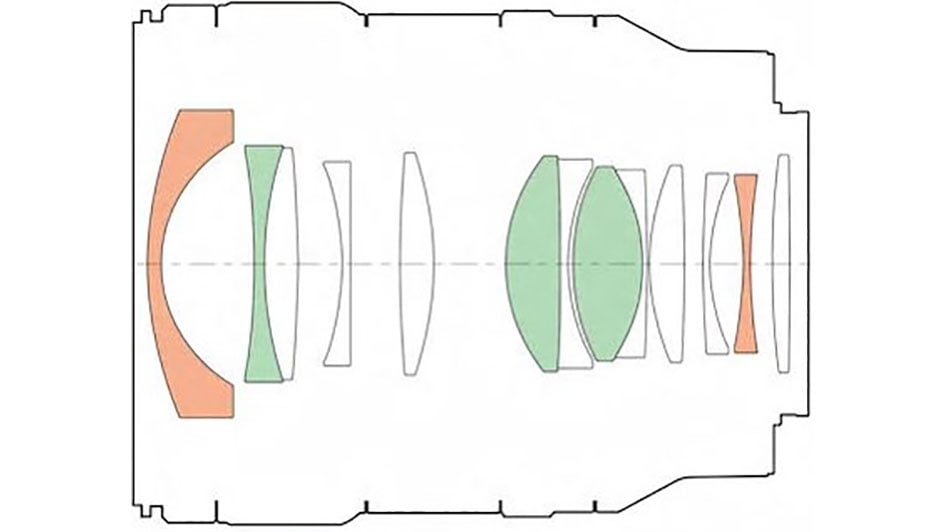
Closest focus distance is 0.23m (9.1in.) in manual focus with a magnification of 1:5.4. A magnification of 1:10 is achieved at 0.34m distance. The Sigma Art and the Zeiss Batis both achieve similar magnifications of 1:5.3 and 1:4.8 respectively. [0]
Filter-thread: 67mm, same as with the Zeiss Batis. The Sigma Art takes 77mm filters. [+]
Image stabilization: No optical stabilization of the lens. The Sony A7 bodies provide built-in sensor-shift stabilization. Same with the Sigma Art and the Zeiss Batis. [0]
Auto focus: Built-in AF drive. Manual-focus override is by simply turning the focus ring. The focus ring has a linear gearing that allows for precise manual focus and makes smooth focus pulling for videographers easy but offers no distance markings. There’s a customizable focus-lock button on the barrel that the competition does not offer. The Zeiss Batis offers a display for focus distance and depth of field and its gearing is non-linear: this allows for even more precise manual focus when turned slowly but makes smooth focus pulling for videographers almost impossible. Focus on the Sigma Art works differently as it has a direct linear mechanical coupling between the focus ring and the focus action. It also offers the distance and dof markings that normally come with lenses designed for DSLRs. [+]
Covers full frame/FX or smaller. Same with the competition. [+]
Price: The lens currently sells for 1600 EUR (incl. 19% VAT) / 1400 USD. The Sigma Art goes for much less: 730 EUR / 850 USD. The Zeiss Batis lies in the middle at 1130 EUR / 1200 USD. [-]
The Sony GM lens comes with a padded pouch including a strap and the lens hood is included. It is reversible for transport and has a locking mechanism to prevent it from accidentally falling off. The Sigma Art has a padded pouch too but no strap and the lens hood has no lock. The Zeiss Batis comes without a pouch. [+]
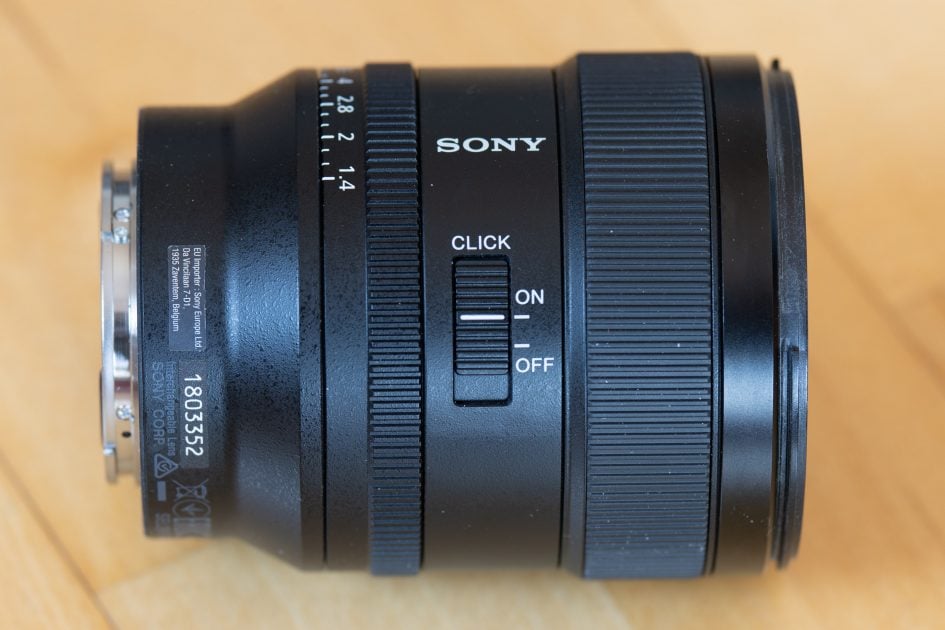
Aperture ring: yes, with 1/3 stop clicks. Set the ring to “A” and the aperture is controlled by the camera or turn it to set the aperture from the ring. There is no lock to prevent the ring from being accidentally moved from the “A” position but the lens has a switch to turn the clicks off so that the aperture can be operated continuously, smoothly, and noise-free. Neither the Sigma Art nor the Zeiss Batis have an aperture ring. [+]
Sealing: yes, a rubber grommet at the lens-mount plus further special weather-sealing throughout the construction, just like the Sigma Art and the Zeiss Batis. [+]
The score in the “features-department” is 1[-]/2[0]/9[+], the most distinguishing features of the lens being the de-clickable aperture ring, the lockable lens hood and the focus lock button. Plus it is pretty compact for an f1.4 lens and well protected against the elements. Its only drawback is the high price.
Three wide-angle prime lenses
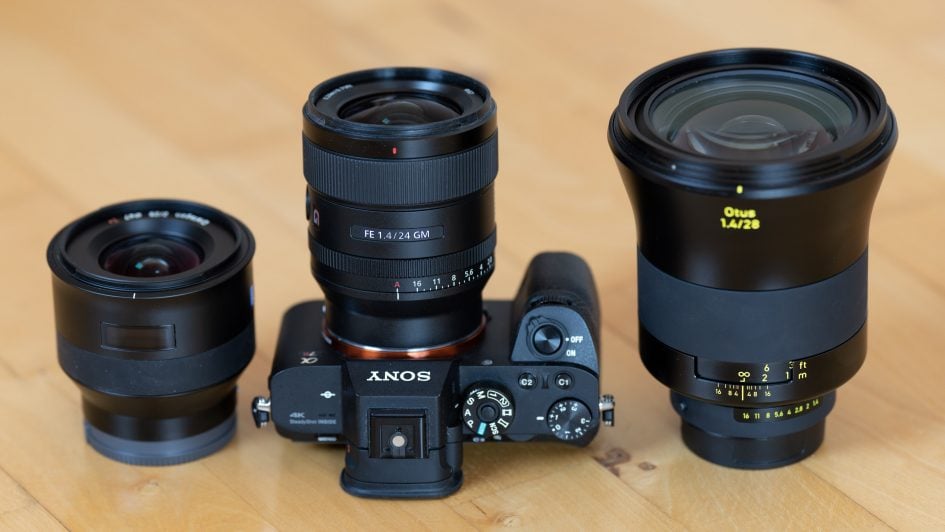
Above from left to right: Zeiss 25mm f2.0 Batis, Sony FE 24mm f1.4 GM, Zeiss 28mm f1.4 Otus (needs E-mount adapter)
Alternatives
If you want a 24mm lens with E-mount, autofocus, and an f1.4 focal ratio there is just one alternative:
- Sigma offers the AF 24mm 1.4 DG HSM Art (730 EUR / 850 USD). It’s an optical design from 2015 for DSLRs which is available in E-mount since 2018. See my Sigma 24mm f1.4 Art review where it earned a Highly Recommended.
If you consider slower, manual focus lenses, or adapted lenses there are some other alternatives, e. g.:
- Zeiss has the 25mm f2.0 Batis from 2015 for 1130 EUR / 1200 USD. Its one stop slower focal ratio is the biggest disadvantage over f1.4 primes. The 1mm longer focal length should not make a big difference. See my Zeiss 25mm f2.0 Batis review where it earned a Highly Recommended.
- Zeiss also offers the 28mm f1.4 Otus from 2014 which is manual focus only and can be used on an EF to E-Mount adapter. The lens is extremely big and heavy (1.3kg) and sells for a whopping 4500 EUR / 5000 USD. But its optical performance is top notch. See my Zeiss 28mm f1.4 Otus review where it earned a Highly Recommended.
- Samyang/Rokinon/Walimex has a 24mm f1.4 ED AS UMC lens for Sony E-Mount from 2013 but only for manual focus which costs around 540 EUR / 500 USD.
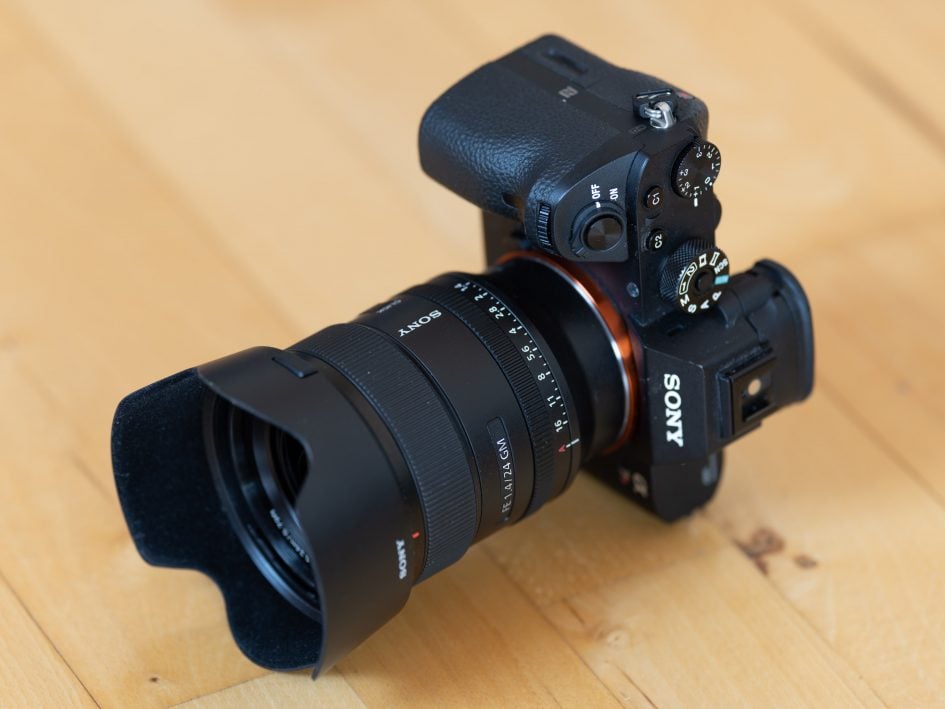
Focus
Focus accuracy and repeatability is critical to consistently produce sharp shots especially with large aperture lenses. Repeatability (the accuracy of focus on the same subject after repeated focus-acquisition) of this lens is very good (measured 98.8% in Reikan FoCal) with no outliers over a series of 40 shots. There is only a very slight focus variation whether the lens focuses from a closer distance or from infinity.
The lens focuses in around 0.5 sec on an A7R II from infinity to 0.34m (1:10 magnification), which is very fast. The Sigma Art was a little slower at 0.6 sec but that was measured on a Nikon D810. The focus ring is 13mm wide. It moves very smooth and can easily be operated with one finger.
AF-operation of the lens is inaudible from the outside and if you record video with the built-in microphone the AF-drive produces no sound. As you pull focus, you’ll notice some focus breathing: the image becomes 6% more magnified when I adjusted the focus from infinity to 0.34m. This could be distracting when shooting videos.
Next check out my quality results!
Check prices on the Sony FE 24mm f1.4 GM at B&H, Adorama, or Wex. Alternatively get yourself a copy of my In Camera book or treat me to a coffee! Thanks!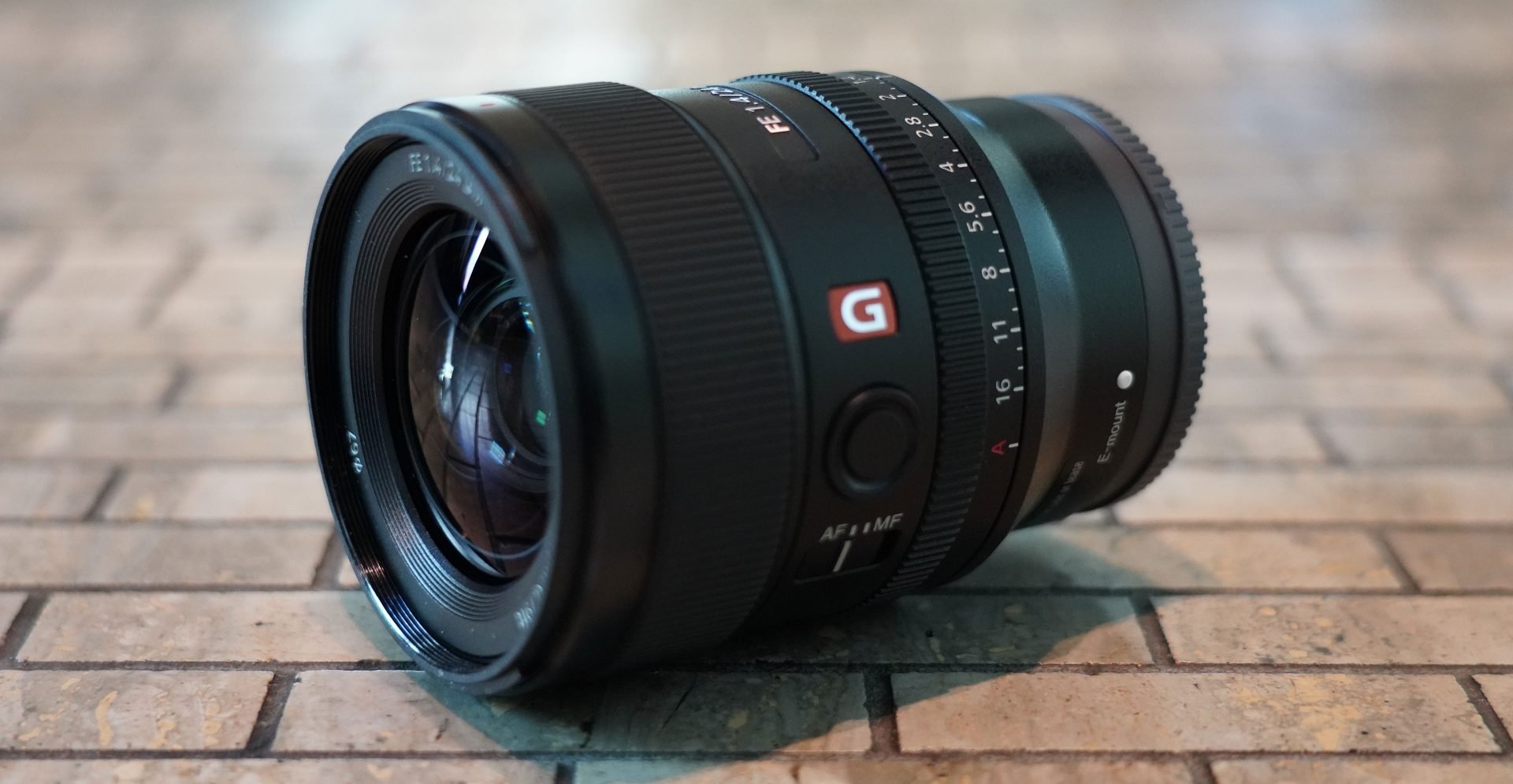
 The Sony FE 24mm f1.4 G Master is a wide-angle prime lens designed for its Alpha series of full-frame mirrorless cameras. The lens delivers a popular field-of-view that’s wider than 28mm without the distortion related to wider options, while the bright f1.4 focal ratio is ideal in low-light and also for delivering shallow depth-of-field effects, especially when the subject is positioned close to the minimum focusing distance of 24cm. In my tests, the Sony FE 24mm f1.4 GM was a winner: sharp into the corners of a full-frame sensor, light and small, with good resistance against flare, glare and ghosting, and a nice background Bokeh too. The de-clickable aperture ring, lockable lens hood, and focus lock button are a nice bonus. This together with its thorough weather-sealing supports Sony's high-end claim of the G Master series. All in all the Sony FE 24mm f1.4 GM justifies its price and although I'd wish for less longitudinal CAs the lens clearly earns a Highly Recommended!
The Sony FE 24mm f1.4 G Master is a wide-angle prime lens designed for its Alpha series of full-frame mirrorless cameras. The lens delivers a popular field-of-view that’s wider than 28mm without the distortion related to wider options, while the bright f1.4 focal ratio is ideal in low-light and also for delivering shallow depth-of-field effects, especially when the subject is positioned close to the minimum focusing distance of 24cm. In my tests, the Sony FE 24mm f1.4 GM was a winner: sharp into the corners of a full-frame sensor, light and small, with good resistance against flare, glare and ghosting, and a nice background Bokeh too. The de-clickable aperture ring, lockable lens hood, and focus lock button are a nice bonus. This together with its thorough weather-sealing supports Sony's high-end claim of the G Master series. All in all the Sony FE 24mm f1.4 GM justifies its price and although I'd wish for less longitudinal CAs the lens clearly earns a Highly Recommended!



